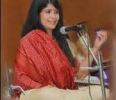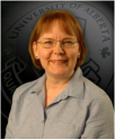AIRS 3rd Annual Meeting Abstracts
|
SUB-THEME: 1.1 PERCEPTION AND PRODUCTION OF SINGING ** Vocal Sensorimotor Development and Singing in First Graders ** Rayna Friendly (McMaster University) friendr@mcmaster.ca, Jennifer Walsh (McMaster University), Christine D. Tsang (Huron University College), Laurel J. Trainor (McMaster University, Rotman Research Institute) Abstract: Introduction: Although singing is a universal human behavior, we know very little about its development. Several studies in the music education literature and neuroimaging studies of adult singers indicate that sensorimotor integration of vocal production and auditory perception mechanisms are critical to singing proficiency. These studies also indicate that music training and vocal practice are highly related to singing ability. However, it remains unclear how production and perception mechanisms are affected by these factors, and what role they play in singing development during childhood. Method: Two classrooms of grade 1 children participated in the study. One group of children received a special music program for one hour per week during the school year, while the other group participated in a traditional music education curriculum. A set of matched auditory perception and vocal production tests (VAMDA) were administered individually to all children: once at the start, and once at the end of the school year. Tests of social competence and cognitive ability were also administered. Results: Testing is still in progress. Preliminary results will be presented at the AIRS meeting. Results will indicate 1) whether children’s singing abilities change substantially over the course of a school year, 2) if the music program facilitates singing ability in comparison to the no program group, and 3) if cognitive level and social competence are related to singing proficiency. Discussion: Using the VAMDA, we hope to be able to provide evidence for the vocal sensorimotor loop model of singing, proposed by Berkowska and Dalla Bella (2009). In this model, several factors contribute to singing proficiency, however how the loop develops during childhood is not well understood. By testing singing, cognitive and social abilities in children both pre- and post- training we hope to be able to provide a more rounded examination of singing development. SUB-THEME: 1.1 PERCEPTION AND PRODUCTION OF SINGING ** Memory for Melody in Children with Specific Language Impairment ** Amy Fancourt (Goldsmiths, University of London) a.fancourt@gold.ac.uk Abstract: Introduction: Specific Language Impairment (SLI) is a developmental language disorder that is also associated with cognitive impairments at the level of short-term and working memory (Archibald & Gathercole, 2006a). Children with SLI demonstrate difficulties memorising rote sequences of digits or words (Fazio, 1997). However, it is not yet known whether these deficits generalise to memorising sequences of tones in the musical domain. Those diagnosed with SLI are at risk of poor academic, educational and psychosocial outcomes (Conti-Ramsden, 2009). Singing has the potential to be used as an intervention to improve psychosocial outcomes for children with SLI. However, we first need to consider the extent to which the cognitive impairments implicit in the syndrome may impact upon memory for melody. Method: Seven children diagnosed with SLI (6-10-yrs, Mean age 8) were required to make same/different judgments about pairs of novel tone sequences ranging between 2 and 5 tones in length. The 'different' pairs were manipulated across two conditions. In condition one, the melodies varied at a global level, in which a displaced relative pitch interval changed the overall shape of the contour. In condition two, the melodies varied at a local level, in which a relative pitch interval was displaced, but the overall shape of the contour was preserved. Results: Signal Detection Analysis (SDA; Swets & Green, 1966) was carried out for each condition to control for response bias. A paired sample T-test, revealed that discrimination accuracy was significantly poorer when the different pairs were varied at the local (interval) level (M=-16, SD=23.61) vs the global (contour) level (M=66.57, SD=35.95); t(6)=-5.54, p = 0.001). There were no significant differences in the performance accuracy across the different tone sequence lengths. Discussion: Children with SLI are able to make correct comparisons of novel tone sequences, provided that they differ at a global level, indicating that, as is found in typical adults and infants, memory for melodic contour is cognitively salient in children with specific language impairment. This finding opens the door to the possibility of utilising memory for contour to encourage musical engagement as a potential therapeutic tool for children with SLI. SUB-THEME: 1.2 MULTIMODAL (AUDIO/VISUAL/MOTOR) ASPECTS SINGING ** Movement, Mimicry and Emotion in Song ** Frank Russo (Ryerson University) russo@ryerson.ca Abstract: Movement can be implied in song through pitch movement, tempo, and a range of other variables. Movement can also be observed in song through facial movements and ancillary gestures. Some aspects of implied and observed movements are correlated. For example, the size of an interval is positively correlated with extent of head movement, eyebrow raising and mouth opening. Recent evidence from my lab suggests that observers visually track these observable movements and that they experience spontaneous facial muscle activations that mimic those necessary to execute the movements. I will present a new model of song perception that attempts to integrate these findings. The model suggests that the mimicry of movement in song is an automatic feed-forward consequence of a neural simulation of movement and that mimicry supports emotional understanding as well as predispose the observer to believe in the authenticity of the emotions expressed. SUB-THEME: 1.2 MULTIMODAL (AUDIO/VISUAL/MOTOR) ASPECTS SINGING ** Efficacy of Speech vs. Song to Regulate Stress in 10-Month-Olds ** Niusha Ghazban (Ryerson University) nghazban@psych.ryerson.ca Sandra Trehub (University of Toronto) sandra.trehub@utoronto.ca Frank Russo (Department of Psychology, Ryerson University) russo@psych.ryerson.ca Abstract: The interaction between a mother and her infant has been described as an intricate ‘dance’ involving coordinated singing and movement. It is widely accepted that infant-directed (ID) speech, characterized as having higher pitch, slower tempo, and exaggerated intonations, is an effective means of communicating with infants and holding their attention. Infants similarly show a preference and respond to ID singing (Trainor, 1996). In fact, singing is one of the most powerful and universally observed care giving behaviours and one which mothers intuitively use to change and accommodate their infants’ state (de I’Etoile, 2006; Trehub & Nakata, 2003). While both ID speech and singing appear to be equally successful in modulating 'infants’ attention and arousal (Nakata & Trehub, 2004), the consequences of maternal speech and singing to regulate stress are less clear. Thus the current study examines infants’ behavioral (gaze, vocalization, facial animation) and physiological responses (heart rate and galvanic skin response), to their mothers’ singing vs speech following an acute stressor. Using the Face-to-Face/Still- Face (FFSF) procedure (Tronick et al., 1978), the mothers and infants engaged in a three stage interaction: 1) Face-to Face playtime, 2) Mother’s display of neutral still-face and, 3) the Reunion phase. The last phase is controlled such that mothers re-engaged with their infants by either singing or speaking. Infants were subjected to four repetitions each of singing and speech conditions for a total of eight trials over a 30-minute session. Although data analysis is still ongoing, it appears that maternal singing provides a form of “homeostasis” in regulating infants’ arousal more effectively than speech. SUB-THEME: 1.2-MULTIMODAL (AUDIO/VISUAL/MOTOR) ASPECTS SINGING ** Sing to Me Please, Put Me at Ease: Infants' Responses to Infant-Directed ** Patricia Brosha (St. Francis Xavier University) x2008kdg@stfx.ca Petra Hauf (St. Francis Xavier University) phauf@stfx.ca Abstract: Introduction: Previous research suggests that infant-directed singing may be effective for sustaining attention and regulating arousal, while infant-directed speaking may be linked to recruiting attention and efficient learning (Nakata & Trehub, 2004). The present study investigated 17 6-month-old infants’ responses to infant-directed singing and speaking form responses to infant-directed singing and speaking from a standardized, non-maternal source to compare these styles of infant-directed communication. Method: Using eye-tracking technology and video recording, infants’ looking behavior and motor behavior were captured in detail as they watched audiovisual displays of an adult engaging in singing and speaking of a familiar and a novel text. Results: Findings showed that overall looking time was significantly longer for episodes of infant directed singing than comparable episodes of infant-directed speaking, which may signal intense engagement. Furthermore, overall looking time was longer for episodes containing a novel text compared to episodes of a familiar text. For specific areas of interest, infants displayed a preference for the mouth region over the eye region regardless of vocal style or text familiarity, possibly reflecting an increasing interest in language. There was no significant difference in infant movement for vocal style or text familiarity. Discussion: Current findings lend further support to the growing body of knowledge on infant-directed communication, and may have implications for infant learning and adult-infant interaction. Infant directed singing may promote emotional engagement, while infant-directed speaking may facilitate information processing. SUB-THEME: SUB-THEME: 1.3 AIRS TEST BATTERY OF SINGING SKILLS ** Improvisations of Estonian Children ** Marju Raju (Estonian Academy of Music and Theatre) marju.raju@gmail.com Jaan Ross (Estonian Academy of Music and Theatre) Abstract: AIRS Test Battery was piloted in Estonia with 26 children ages 4-12. This presentation focuses on results from two components of the Test Battery: component 7 (improvising an ending to a melody) and component 8 (improvising melody for picture). Comparing to other components of the Test Battery, improvisational elements seemed to be most challenging for the participants. Improvisational performances are influenced by various aspects. Results depend on different concepts of song in Estonian and language and culture based connotations on singing. In Estonian language, the word “song” does not have a music-specific meaning. For example, for our historical folk songs (regilaul) it is quite common to use same tunes with different lyrics, so the melody carries rather a helpful device for recalling huge amounts of lyrics from memory. Estonian word laul (song) is also used for poems, epic texts or even stories. As we did not ask participants to define “song” or “singing” nor defined the concept ourselves giving the instructions, definition of “song” could therefore be presented as a scale where spoken words are at one end and words sang with melody in other end. The usage of rhythm on the other hand differs as personal knowingly “sings” or “talks”. Words (with or without a musical melody) recited in the meaning of singing have stronger rhythmic structure, a beat. If the rhythm or speed for spoken words is recognizably altered, it could be considered as singing. Success for completing improvisational components also depend on child´s overall habitude of testing, willingness to perform this kind of exercises and level of performance anxiety. Prior music education seems to influence structure and harmony of improvisations. SUB-THEME: SUB-THEME: 1.3 AIRS TEST BATTERY OF SINGING SKILLS ** Does Accuracy of Singing the Major Triad Predict Accuracy of Contour Production in an Unfamiliar Song? ** Bing-Yi Pan (UPEI) bpan@upei.ca Annabel Cohen (UPEI) acohen@upei.ca Leah Stevenson (UPEI) Abstract: The AIRS Test Battery of Singing Skills was developed to provide information on cultural, experiential and universal factors influencing the acquisition of singing. The Battery was recently administered to 32 students at a Canadian University, one half native Chinese, the other, native Canadian. Participants performed the 11 components of the Battery twice. The present analysis examines performance on Component 6 - Musical Elements and Component 9- Learning an Unfamiliar Song. The 5 musical elements were: first three notes of the major scale, first 4 notes of the major scale, major triad, and ascending and descending major scale. Participants heard a model (sung on the syllable la) and then echoed the example (on la). The unfamiliar melody of Component 9 had 5 phrases in a major key. The English lyrics were translated into Chinese, and one half of each language group of participants was presented with Chinese; the remainder heard English. Regardless of the language of the lyrics, the melody was to be sung back on la in both sessions. Component 6 items were scored by ear on a binary scale; the 5 sung phrases from Component 9 were notated by ear, and their correctness was scored in binary for a maximum score of 10 when collapsed over the 5 phrases and 2 sessions. Correlations were performed between scores for the 5 elements from Component 6 and overall performance of Component 9. Performance on the major triad significantly correlated with ability to sing the contour of the unfamiliar song correctly. This finding is surprising because contour does not require accurate interval representation but accurate singing of the major triad does. We seek further confirmation as we search for common factors which can both explain variation in performance on the AIRS test battery and contribute to the development of a model of acquisition of the skills of singing. SUB-THEME: SUB-THEME: 1.3 AIRS TEST BATTERY OF SINGING SKILLS ** Mapping out young children's singing: Preliminary English Data ** Mike Forrester (University of Kent) m.a.forrester@kent.ac.uk Jessica Baker (University of Kent), Emma Borthwick-Hunter (University of Kent) Abstract: Introduction: This poster summarizes our preliminary analysis of the AIRS test battery used with young school-aged children in England (UK). Establishing the early singing skills of young children is a central element of the 'Development' theme in the AIRS project and the data reported contribute towards building up a picture of such skills. Method: 104 children between the ages of 4 and 9 years were video-recorded using the AIRS test battery profile (12 components). Children were filmed either in a classroom of staffroom context in a relaxed and informal manner. Employing the battery took approximately 15 minutes per child and the data was collected over 3 month period. Results: Digitization and analysis is currently ongoing and this report describes our preliminary observations. It would seem (a) that there is a clear developmental trend in children's abilities when producing the full vocal range - older children exhibiting a great range; (b) older children also produce more imaginative spontaneous singing when asked; (c) there are indications of gender differences with older age groups - with girls exhibiting more creativity than boys, and (d) there are indications of considerable variability in the singing of the youngest children. Discussion: The implications of our preliminary findings are considered with reference to contemporary work on young children's singing abilities. SUB-THEME: 2.1- LEARNING TO SING NATURALLY (Relates to 2.3- TEACHING THROUGH SINGING) ** Traditional Children's Songs of the Wagogo of Central Tanzania ** Kedmon Mapana (Seattle Pacific University) mapank@spu.edu Abstract: Introduction: The Wagogo people of central Tanzania are a Bantu ethnic group living in rural, pastoral and agricultural communities about 300 miles inland from the Indian Ocean. Most of the children's songs among the Wagogo people are naturally acquired from an enculturation process by which songs are “learned but not taught” (Rice, 1994). As a field researcher with an ethno musicological perspective, I was graciously accepted by the village community to examine songs of Wagogo children of Chamwino, a village about 300 miles from the capitol city of Dar es Salaam. Method: Using observation, participant observation, and video: and audio-documentation, data were gathered from 150 children, ages 4 to 12. Results: Most of the children's songs of the Wagogo people are sung in unison, unaccompanied, and call and response is a formal characteristic of the songs. The focus on singing is a priority for AIRS, but, for the Wagogo children, movement and dance are not separated from the singing. Consistently featured dance movements include the limbs, head and torso. Topics such as family needs, moral issues and birds are evident in the song texts. Also, most of the songs were spoken instead of sung, the use of three to four pitches was common and most of the songs were familiar to me. Discussion: There is concern about the disappearance of Wagogo children's songs in Chamwino, and of their wholesale abandonment by communities. The Wagogo people, along with many other groups of people in Tanzania, are being swept into more contemporary musical trends to the extent that some are abandoning their interests in long-standing traditional music and dance forms. Based upon my findings in this research project, I recommend the following: 1) AIRS should make these recorded songs available to singers, choir directors, and teachers on the AIRS website, but also to the Wagogo of Dodoma, Tanzania. 2) More research and documentation are needed among the Wagogo people before more of the children's songs are swept away by popular culture. Note that this research was accomplished only in Chamwino village, however, I did not get many songs in this village, and then I had to travel to Kawawa village (approximately 30 miles North from Chamwino). SUB-THEME: 2.1 LEARNING TO SING NATURALLY ** Children Singing Online: An Examination Internet-Based Resources ** John Christopher Roberts (University of Washington) cr777@uw.edu Abstract: The movement to honor and value children’s voices has gradually gained steam over the last two decades, and the rise of the Internet allows interested parties to not only read about children’s natural musicking experiences, but also to hear children, singing and laughing and engaging in the musical play that is part of the essence of childhood. The current project, supported by AIRS, surveyed available online resources, to determine the scope and variety of websites containing music of children singing in their natural contexts, with minimal interference by adults. Over fifty websites were examined, and five met the criteria: Smithsonian Folkways, the American Folk Song Collection at Holy Names University, the Florida Folklife Project of the Works Progress Administration, The Association for Cultural Equity, and The Archival Sound Recordings of the British Library. Each website is described, first in broad overview, then with specific sections explaining the overall musical content available on the site followed by particular attention to the musical content of children. Following the description of each website, the transcribed songs from the site are posted, along with relevant information available on the website. Links for all songs are included. After all five sites are described, a classification system is provided. Thirty-four songs are transcribed, representing 15 countries and 23 cultures. Tessituras and ranges vary widely, with the “Inuit Children’s Song ”ranging from A, to E while the children on "Trois Fois Passera" from Canada sing notes from A flat to E flat,’ Most songs fall into duple meter, but the prevalence of asymmetrical or mixed meters can also be found in 12 of the 34 songs. The most common text subject is violence or death, while other topics include animals/nature, food, and work/occupation. SUB-THEME: 2.2 FORMAL TEACHING OF SINGING ** Crisis and Curriculum: A Philosophical Examination of Recent Literature on Male Choral Singing ** Jason Noble (The University of Western Ontario) Carol Beynon (The University of Western Ontario) beynon@uwo.ca Abstract: The word “crisis” is frequently used to describe the state of male participation in choral singing: Weston Noble has remarked that only 7% of the world’s singers are male, and the numbers have been in decline for over a century. Among the many topics addressed in vast body of literature on choral pedagogy published in the last decade, male choral singing is the most intensively pursued area of research. The widespread absence of males in choirs is perceived as having detrimental effects for the males to whom the great benefits of choral singing are denied, for the tradition of choral music and for society as a whole. Two problems perceived to be unique to males, the dramatic voice change experienced during adolescence and the social barrier of hegemonic masculinity, are cited as sources of the “problem of the missing males. “Proposed solutions have tended to focus on organizational structure, repertoire selection, sound pedagogy and the creation of an inclusive atmosphere. However, in spite of the concerted efforts of researchers and the choral profession, the situation has not appreciably improved. In this paper, we examine the literature to explore this apparent disconnect between theory and practice. Drawing on the work of Ornstein and Hunkins we propose that a confusion of philosophical orientations may be at the root of the problem. Since effecting a curriculum of social change and personal development is the stated goal of the literature, a philosophy of progressivism and reconstructionism should be embraced and expounded. In its current state, however, we feel that the literature does not demonstrate a conscious consideration of curriculum philosophy, and as a result perpetuates elements of perennialist and essentialist thinking that inadvertently facilitate the cultural hegemony that impedes males from singing in choir. SUB-THEME: 2.2 FORMAL TEACHING OF SINGING ** What do students expect from a singing lesson? ** Jaan Ross (Estonian Academy of Music and Theatre) jaan.ross@ut.ee Vaike Kiik-Salupere (Estonian Academy of Music and Theatre) Abstract: A successful singing lesson requires coordinated efforts from the three parties involved: student, teacher, and coach. Results of a survey are reported, where 32 originally developed statements were rated on a 5-point Likert scale by high school students, university students, and professional singers of an opera choir. The statements were related to students’ expectations of their teacher and coach during individual singing lessons. Participants were also able to add their own comments to the questionnaire. One-way ANOVA showed a difference of high school students in comparison with the other two groups. Analysis of responses to the survey demonstrated that (a) the relationship between the teacher, student and coach should be based on partnership, (b) the teacher should be positively minded, have professional skills and up-to-date knowledge, and be able to inspire the student, (c) the coach’s abilities and skills should be at a sufficiently high level high level, (d) in addition to technical proficiency, the teacher should also develop psychological skills of students helping them to cope with a stress as professional singers. In their free comments to the questionnaire, the five most popular phrases used by respondents turned out to be (1) support of efforts [of the student], (2) understanding, (3) mutual trust, (4) [teacher as] the creator of atmosphere, and (5) positive attitude. Teachers’ nervousness and irritability were described by students as the qualities that should be ruled out in a lesson. Since preparation of students is to a large extent similar in all areas of musicianship, students’ expectations of vocal teachers and coaches are generally expected to be valid also in other fields of training musicians as well. From an even wider perspective, the issues of student-teacher interaction are expected to overlap in all areas that involve learning. SUB-THEME: 2.2 FORMAL TEACHING OF SINGING ** Teaching and Learning Vocal Music in Contemporary India ** Utpola Borah (Ohio State University) utpola@gmail.com Hans Utter (Ohio State University) Abstract: Introduction: The tradition of music education in India (guru/shisya parampara) is currently being supported in a variety of institutional settings. Our poster represents our examination of several examples of this, and highlights the training methods and compare the strengths and weaknesses of various programs with a particular focus on the role of singing or the teaching of singing. Method: The methods included collecting ethnographic data through interviews and audio/video recordings, participation in learning situations, and examination of data regarding the success rate of various programs. The data on the formal training settings was then compared cross-institutionally and with informal educational settings. Results: Certain institutions are more suited than others in the production of highly qualified artists and performers. It was found that the preservation of individualized instruction and reliance on oral transmission was superior to a standardized curriculum. However, the assessment of student progress requires standardized assessment tests. Discussion: For North Indian classical vocal music, the systems of oral transmission and individualized training appears to be necessary for the requires of this art form. However, the balance between individualized instruction and institutional settings is difficult to maintain. SUB-THEME: 2.3 TEACHING THROUGH SINGING ** Sing a Song or Read Along ** Robyn Wells (St. Francis Xavier University) Sarah Drake (St. Francis Xavier University) Jennifer Sullivan (St. Francis Xavier University) jfsulliv@stfx.ca Abstract: Introduction: Previous research has shown the positive influence of music on vocabulary development. The current study investigated two vocabulary intervention techniques with pre-school aged children and determined whether singing or storybook reading has a greater effect on the ability to learn new vocabulary. Method: Eight children from two different daycare centres were assigned to one of two conditions, a singing condition or a storybook condition. All children were pre-tested for their knowledge of 36 vocabulary words using a Picture Vocabulary Test (PVT) developed for this study. Children in each condition received 8 weeks of vocabulary intervention consisting of learning 10 songs or listening to 10 storybooks. Twenty-eight of the target vocabulary words were used in both the stories and songs and two sets of an additional 4 words were only present in each type of intervention. After the intervention, the children were post-tested for knowledge of the same vocabulary words Results: As hypothesized, children in the singing intervention showed significantly greater vocabulary acquisition than those in the storybook condition. Discussion: Singing intervention proved to be a useful way to teach children new words. The intervention was extremely enjoyable for the young children. This is an inexpensive and accessible alternative to storybook reading. SUB-THEME: 2.3 TEACHING THROUGH SINGING ** The Effects of Singing on the Acquisition of a Novel Language ** Henrietta Lempert (University of Toronto) lempert@psych.utoronto.ca Wendy Xin (University of Toronto) Abstract: Even after many years of English immersion, post-puberty L2 learners from a variety of first languages may have great difficulty supplying bound inflectional morphology (e.g. Yesterday, she cook supper; My child like to play; My house has many room). Our research program uses a novel language to investigate whether singing voice presentation enhances perception of inflections as compared to speaking voice presentation. In this poster, we will present our methodology and the results of our pilot study. Our language comes in two versions (dialects), a prefix version ("ohift puser ievab") and a suffix version ("hifto puser vabie"). The learner must attend to the prefixes/suffixes in order to master the rules of the language (e.g., there can be only one ie-word and one o-word in each sentence). Each language has been recorded in two formats; a) speaking voice (with natural speech prosody cues to the phrase structure) and b) singing voice (in which differences in pitch are cues to the phrase structure). Dialect and format are completely crossed between-participant variables. Participants listen and repeat each study sentence (24 exemplars of legal sentences), following which they judge the acceptability of another 16 legal and 16 illegal sentences. Four cycles of study-test trials are presented, using speaking voice presentation of tests in both formats (in order to confirm that singing voice participants will generalize to speaking voice format). To date, we have data from eight Introductory Psychology research participants (two in each Dialect x Condition cell). It will be possible to add data from an additional 20 students by the end of June, which will give us a sufficiently large sample to discern the effects of our manipulations. SUB-THEME: 2.3 TEACHING THROUGH SINGING ** The benefits of singing on second language learning ** Arla Good (Ryerson University) agood@psych.ryerson.ca Abstract: Introduction: The current study extends to second language learning the popular notion that memory for text can be supported by song. In the context of a second language classroom, singing can be intrinsically motivating, attention focusing, and simply enjoyable for learners of all ages. For native text, the melodic and rhythmic context of song enhances recall of text (Wallace, 1994). However, there is limited evidence that these benefits extend to learning of foreign text. Method: In this study, Spanish-speaking Ecuadorian children learned a novel English passage for two weeks. Children in a sung condition learned the passage as a song and children in the spoken condition learned the passage as an oral poem. After the third learning session, children were asked to reproduce the passage in the method in which they were taught (sung or spoken) while reading the lyrics and were tested on their ability to correctly pronounce the foreign words. After the fourth session, children were tested on their ability to recall verbatim as many of the words as possible and they were asked to translate 10 target words (or terms) from the passage into Spanish. Results: As predicted, children in the sung condition demonstrated superior verbatim recall. In addition, their pronunciation of vowel sounds and translation success were enhanced. The benefits of learning through music persevered after a six-month delay. Discussion: Findings have important implications for second language instruction. The poster will also consider mechanisms such as dual encoding and automatic rehearsal that may be responsible for the gains observed in learning second language through song. SUB-THEME: 3.1 SINGING AND CROSS-CULTURAL UNDERSTANDING ** Fostering Understanding in Society: Ateete, an Arsi Oromo Women‟s Musical Ritual in Ethiopia** Leila Qashu (Memorial University of Newfoundland) l.qashu@mun.ca Abstract: In Arsi Oromo society in Ethiopia, although women have no formal political authority, and are not directly involved in men’s dispute resolution ceremonies, they have religious power that intersects with the political sphere. In the case of gender abuse, when a woman has been dishonoured by another person in any way (verbally, physically or other), she can gather with other women in front of the person’s house to perform a song and poetry-based ritual called Ateete, at the end of which the offender is expected to confess his guilt, offer a gift and ask for forgiveness. In this paper I will discuss my doctoral research, for which I have been conducting field research in Ethiopia this past year. I will discuss the ritual in detail in order to demonstrate how women teach and remind the men in society how to behave, and how both segments of society learn to understand, apologize and forgive. I will also discuss a cross-cultural case study, in which the ritual was used to resolve a dispute between people of two different ethnic groups. Through video and audio recordings of interviews and descriptions of research on the field, I will present examples of the rituals, the participant’s voices and how they view their rituals in society. SUB-THEME: 3.1 SINGING AND CROSS-CULTURAL UNDERSTANDING ** Kenya Case Study: National Boys Choir, School Singing, Laipikia ** Jim Sparks (Simon Fraser University) jaz24@shaw.ca Abstract: Introduction: This particular study focus is on singing expression in Kenya and is part of several case studies (Cuba, Ukraine, Denmark)I am conducting in skilled authentic singing. The following questions are explored on the part of choral leader and singer: What are the discernable qualities of expressive singing on the part of the listener and the singer? What value is placed on these qualities in the context of the conductor and singers’ cultural tradition? What are the skills employed in accessing expressive, authentic singing? What is the role of repertoire in the relationship between skill and expression? In what ways is there demonstrated ‘knowledge or ‘way of knowing evident in the singing? (Elliot 2005). Method: The study uses a qualitative, emergent design to build on and extend our understanding of existing theory and practice focused on the interdependent relations between skill an expression in choral singing across different cultural traditions. The aim of the data collection is to build a rich, descriptive account of the complexity of culturally diverse forms of musical expression within the context of specific choral performances.a) Participants: National Boys Choir of Kenya: a) 24 singers drawn from 42 tribes in Kenya: ages 17-23. b) Children from Schools surrounding the Ol Pejeta Conservancy, Nanyuki, Kenya. b) Procedure: In depth data collection including: field notes of observation and interviews,video footage of singing performances/rehearsals and interviews of conductors and singers through translation, audio recordings of singing performances and rehearsals, documentation contextualizing the collected data. I also taught Canadian repertoire including the National Anthem to several choirs. Data analysis will involve an inductive, narrative approach and a classification system similar to the one proposed by Lofland and Lofland (1984) for classifying 'social phenomena' as acts, activities, meanings, participation, relationships, and settings. Obtaining different perspectives from observations, field notes, interviews, documents, visual and aural digital recordings, will provide a rich data set that can be cross-referenced to establish validity and deepen insights obtained from different sources. Strauss and Corbin (1990). Results: As the exchange took place in March/ April of 2011, the results are very preliminary and emerging. I would benefit greatly by the feedback/discussion from AIRS collaborators to my initial analysis. The following observations will form direction for this study: 1. The singing observed in Kenya has deep rooted connection to the singers past tribal traditions. Songs and dances are intertwined with life events, which instill an unquestionable pride and value of singing 2. Leadership and relational skills have been a dominant force in the singing process in Kenya. Discussion: *Relevance to AIRS Milestone Document: 3.1 Intercultural understanding. This study will contribute to the existing qualitative study (2) and (3) in leading to a deeper understanding of the processes involved that lead to the dynamic singing of Kenya and Africa as a whole. SUB-THEME: 3.2 SINGING AND INTERGENERATIONAL UNDERSTANDING ** Intergenerational curricula, multimodal communication, and identity options: Findings from a study of an IG art program as a basis for a study of IG singing curricula ** Zheng Zhang (University of Western Ontario) Rachel Heydon (Western University) rheydon@uwo.ca Abstract: This poster reports on those aspects of a qualitative case study of an intergenerational (IG) art curriculum that could be relevant for the development of an IG singing curriculum. The goal of the research is to understand the constituents of successful IG curricula such that they can create expansive communication learning opportunities and identity options for young children and older adults. The study found that when compared to the adults, children’s communication and indentify options are less restricted, and IG curricula could address the need to keep these opportunities and options open throughout the life span through measures such as sustained, meaningful IG programs that focus on supporting participants’ facility with a variety of communicational modes and media. The findings of the art study are now being transferred to a study of the development and implementation of IG singing curricula which is making inquiries into at least three areas of IG singing programming: Intrapersonal characteristics: what is the relationship between communication options, interests, identity options, and their connection to young children’s and older adults’ well-being in the context of IG singing curricula?; Interpersonal factors: how are reciprocal relationships forged in and through IG singing curricula?; Systemic features: what structural, organizational supports are necessary for successful IG singing curricula, and how are larger social Discourses instantiated (and perhaps disrupted) within IG song and curricula? SUB-THEME: 3.3 HEALTH BENEFITS OF SINGING ** Singing Improves Self Assessed Intelligibility in People with Parkinson’s Disease ** Merrill Tanner (Glenrose Rehabilitation Hospital/ University of Alberta) merrillt@ualberta.ca Lili Liu (University of Alberta) Leonard Ratzlaff (University of Alberta) Melanie Campbell (University of Alberta) Linda Rammage (University of British Columbia) Abstract: Introduction: The loss of voice quality and loudness as Parkinson’s disease progresses is difficult to manage. Effective voice treatment is available, but is hard to maintain over the long course of the disease. A community based voice improvement program drawing on vocal pedagogy and voice therapy was developed and tested as a PhD project. Method: Participants attended 90-minute vocal exercise and choral singing sessions twice weekly. In addition to other measures each participant completed a Self Assessment of Intelligibility (Kent, 1994). Results: A statistically significant change at the .01 level of significance was found on Self Assessment of Intelligibility using a student’s t test comparing means of the group before and after treatment. Discussion: Participants perceived a difference in how easily others understood their speech after the voice treatment. They also organized funding for a continuation voice group, which has had good attendance despite -35 degrees Celsius on more than one occasion. SUB-THEME: 3.3 HEALTH BENEFITS OF SINGING ** Caregiver Measures for Singing-Related Behaviour Change in a Dementia Population: A Pilot Study ** Sally Busch (Carleton University) ssimpso6@connect.carleton.ca Carina Daugherty (Carleton University) Mary Gick (Carleton University) Abstract: Dementia is a progressive disorder that results in memory loss and cognitive decline. Some limited research has suggested that participation in musical activities, in particular singing, may have positive effects on health and well-being among individuals with dementia. The measurement of these effects is problematic, however, as individuals with dementia may not be capable of reliably completing self- report measures. Further, due to the variability of this disease both within and between individuals, it may be difficult for a removed observer to assess change. Thus, this pilot study was designed to assess the viability of using caregiver measures as a means of assessing the impact of singing sessions amongst individuals with dementia. Residents (n = 21, all women) of a long-term care facility for individuals with dementia participated in twice weekly singing sessions for four weeks. During these sessions, caregivers (n = 3) were asked to fill out a measure noting any change in the residents’ behaviour as well as their familiarity with each participant. At the end of the four weeks, as well as at a follow-up session four weeks later, the caregivers were asked if they observed any changes in the behaviour of the residents that persisted outside of the sessions. Results indicate the usefulness of caregiver measures as a source of both context and content for the effects of singing in this population. They also suggest that singing has a positive impact on individuals with dementia, although these effects may not extend beyond singing sessions. Discussion addresses shortcomings of measures including observer bias to report positive changes and comparability of qualitative vs. quantitative measures. Suggestions for future studies include clarification of what constitutes a significant change, and consideration of whether behavior during singing should be measured against normal daily behavior (e.g., self-care) or other engaging (e.g., exercise) activities. SUB-THEME: 3.3 HEALTH BENEFITS OF SINGING ** Qualitative Research Interviews about Singing: First Experiences ** Marya Stonehouse (University of Saskatchewan) mrj.stonehouse@gmail.com Katie McCaw (University of Saskatchewan) Jennifer Nicol (University of Saskatchewan) Abstract: Qualitative research interviews are the bedrock of qualitative research. There are different types of qualitative research interviews (Patton, 2002) and different philosophical assumptions informing them (Kvale, 1996). Done well, qualitative research interviews generate rich data that provide specific, focused descriptions about different aspects of the lifeworld, i.e., the everyday lived world of participants (Kvale, 1996). However, despite appearing straightforward to implement, qualitative research interviews are an acquired skill. In this poster presentation, various terms associated with qualitative interviewing will be summarized along with common features of qualitative research interviews, different types of questions, and common characteristics of effective interviewers. Then the grounded theory AIRS project, Singing Your Way to Health, will be described. Grounded theory is an established research method used to generate mid- range explaining a social process, in this case, choir members’ experiences of singing as a health- promoting activity. Interviews are typically used to generate data for grounded theory studies. This project, Singing Your Way to project, Singing Your Way to Health, was the setting for two student interviewers’ beginning experiences with qualitative research interviews. Critical incidents, learning, and reflections will be identified with the intent of providing practical tips for other novice student researchers and for researchers unfamiliar with qualitative research interviews. SUB-THEME: 3.3 HEALTH BENEFITS OF SINGING ** Healing and Mantra: Background and Research ** Hans Utter (The Ohio State University) utter.3@osu.edu Abstract: Introduction: The chanting of specific sacred sounds, known as mantras, is central to Hindu and Buddhist spiritual and ritual practices. Mantras are utilized for healing and overall well-being. Method: I examine the philosophical, psychological, and physiological aspects of mantra within Hinduism. I explore the health benefits associated with mantra chanting through the analysis of sonic and performative dimensions. Results: I outline potential research directions which can test the claims of the healing powers of mantras through the both empirical and subjective modalities. Discussion: Sacred sound and chanting are common to many traditional cultures. This study can be utilized in cross-cultural comparisons of chanting, as well as increasing the overall understanding of these practices and potential health benefits.
|
 |
Amy Fancourt has a BSc Honours in Psychology from The University of Durham, an MSc in Cognitive Neuropsychology from The University of London, Birkbeck College and is currently working towards a PhD in psychology at the University of London, Goldsmiths College. Her research interests include music perception and cognition in children with atypical language profiles. |
 |
Rayna Friendly received her Bachelors in Honors Psychology, with a Minor in Sociology from McMaster University in Ontario, in 2007. During this time, she took on many leadership roles, including acting as an executive member on McMaster’s Psychology and Sociology Societies, as well as President of McMaster’s Vocal Ensemble. Currently, she is a Phd candidate at McMaster in the department of Psychology, Neuroscience and Behavior. As a member of the Infant Auditory Lab, Rayna works under the supervision of Dr. Laurel Trainor: a leading researcher in the field of auditory development and music cognition and perception. Rayna has been singing in school choirs and small ensembles for over 10 years and is currently a member of McMaster University’s Vocal Ensemble. In her research, Rayna has extended on her interest of the voice, and of singing, by studying the development of voice discrimination during the first year of infancy, as well as the interaction of vocal production and perception in the development of singing ability during childhood. Rayna loves working in a field that allows her to combine her interests of psychology and music, and looks forward to interacting with the many vocal enthusiasts at this year’s upcoming AIRS meeting. |
 |
Frank Russo is Associate Professor of Psychology and Director of Psychological Science Training at Ryerson University in Toronto, Canada. After earning his Ph.D. from Queen's University at Kingston in 2002, he completed Post-Doctoral Fellowships in Music Cognition and Hearing Science. In 2006, he founded the Science of Music, Auditory Research and Technology (SMART) lab at Ryerson University. With respect to AIRS, Russo is working on projects spanning all three themes and is leader of Theme 1. Current research outside of AIRS includes projects on vocal emotional communication, multimodal perception, and cognitively based music information retrieval. Previous work includes consultation with U.S. and Canadian Departments of Transportation on locomotive horn effectiveness, and invention of a sensory substitution technology supporting perception of music by deaf and hard of hearing individuals. Current research funding has been awarded by the National Sciences and Engineering Research Council, Social Sciences and Humanities Research Council, Federal Economic Development Agency for Southern Ontario, and the Ontario Ministry of Research and Innovation. |
 |
Niusha Ghazban (M.A., Ryerson University, 2009; B.Sc., McMaster University, 2007) worked with Dr. Daphne Maurer as an undergraduate at McMaster University and is currently in second year of her doctoral studies working with Drs. Jean-Paul Boudreau and Frank Russo at Ryerson University. With Over 5 years of research experience examining infants’ cognitive and perceptual processes, she has presented at various professional meetings such as International Conference on Infant Studies (ICIS) and Society for Research in Child Development (SRCD). Under the supervision of Dr. Frank Russo and in collaboration with Dr. Sandra Trehub, the current project submitted for presentation examines the effects of maternal singing and speech on regulation of stress in 10-month old infants. For her doctoral comprehensive, she is conducting a major review paper examining the effects of song and music on regulating stress in infants. The review highlights the notion that music and song are a form of “distal communication” that can modulate arousal and attention when physical proximity to soothe the infant is not possible (e.g., driving in a car). Specifically her project reviews current literature on how these effects can be applied to other special populations such as premature and low-birth weight infants when the natural bond and attachment between them and the caregiver is disrupted. This review as well as the submitted proposal was motivated by interactions with Drs. Russo and Trehub in the context of AIRS. |
 |
Patricia Brosha recently completed her undergraduate degree this spring at St. Francis Xavier University. She did her Honours in Developmental Psychology, where her thesis research investigated infants' attentional and behavioral responses to infant-directed singing and speaking, under the supervision of Dr. Petra Hauf, Canada Research Chair. Tricia began her research with AIRS in the summer of 2010 as a summer research assistant in the developmental laboratory of Dr. Hauf, where her primary work focused on the development of an AIRS study using eye-tracking technology with 6-month-old infants. Tricia hopes to attend graduate school in the future, focusing in the fields of early childhood development or clinical child psychology. |
 |
Petra Hauf is a professor of psychology at StFX and a Canada Research Chair in Culture and Human Development. She is a researcher in infant cognitive development focusing on the link between perception and production in cognitive development. She received her doctoral degree from Johann Wolfgang Goethe University in Frankfurt, and previously worked as a senior research scientist at the Max Planck Institute for Human Cognitive and Brain Sciences in Munich, Germany. Prior to coming to Canada, she was an assistant professor of psychology at the University of Frankfurt. Dr. Hauf currently collaborates with numerous research scientists who work at high profile universities and research institutes in North America and Europe. These collaborations include work with Claes von Hofsten at the University of Oslo, Norway, Martin Giese at the University of Tuebingen and Birgit Elsner at Potsdam University in Germany, as well as Renee Baillargeon at the University of Illinois, Champaign-Urbana and Nick Stergiou at UNO, Omaha, USA. In Canada, she works together with Chris Moore at Dalhousie University and Diane Poulin-Dubois at Concordia. |
 |
Jessica Baker is in the Bsc Social Psychology program at the University of Kent |
 |
Emma Borthwick-Hunters in the Bsc Psychology degree at the University of Kent. |
 |
Michael Forresteris Lecturer and Researcher in early child development, musicality and language at the University of Kent |
 |
Dr. Bing-Yi Pan received his Ph.D. in physics in 2010 from the Institute of Physics, Chinese Academy of Sciences, Beijing and B.Sc. in physics in 2004 from Shandong University, Jinan Simultaneously he received his B.A. in music education in 2008 from Central Conservatory of Music, Beijing. Currently, he hold AIRS postdoctoral fellowship at UPEI with Dr. Annabel Cohen, is working on the AIRS Test Battery and also contributing to the Chinese component of the 3.1 project on singing and cross-cultural understanding. He is also interested in formal teaching of singing. |
 |
Dr. Annabel J. Cohen is the Director of the AIRS MCRI and also leads the AIRS test battery research sub-theme 3.1. She carried out her graduate work in Psychology at Queen’s University, and her undergraduate research at McGill University. She is the Editor of Psychomusicology: Music, Mind & Brain and serves as consulting editor on several other journals. She received her ARCT in voice performance from the Royal Conservatory of Music [ Toronto, and is a Fellow of the Canadian Psychological Association. She is a member of Council of the American Psychological Association. |
 |
Marju Raju is a doctoral student of musicology in Estonian Academy of Music and Theatre. She has a M.Sc. in psychology (2007) form Tallinn University and a master’s degree in musicology (2008) from Estonian Academy of Music and Theatre. She received best student presentation award at AIRS Annual Meeting 2010. Her academic works has been published in Musicae Scintiae, Psychology of Music and Res Musica. Marju Raju is currently employed in civil service. She is working as an analyst at the Ministry of Social Affairs of Estonia where she is responsible for coordination of research projects and conducting analysis on gender related topics. |
 |
Jaan Ross studied at the Estonian Academy of Music and Theatre and received his equivalent of M.A. in musicology cum laude in 1980. Later he studied at the Moscow P.I. Tchaikovsky Conservatory and obtained his Ph.D. in musicology at the Lithuanian Academy of Music and Theatre, Vilnius, in 1988. In 1992, he obtained another Ph.D. in psychology at the Abo Academy University, Turku, Finland. His primary research field has been the relationship between music and language, in particular between sounds of music and speech. He is the author of a few monographs or textbooks published in English, Russian or Estonian. In 2003 he was elected a member of the Estonian Academy of Sciences and in 2009 a member of the Executive Council of the European Society for the Cognitive Sciences of Music (ESCOM). He is a member of editorial board of a number of scholarly journals, including Musicae Scientiae, Journal of Interdisciplinary Music Studies and Proceedings of the Estonian Academy of Sciences. He has translated into Estonian or edited translations of books by John Sloboda, Johan Sundberg and Nicholas Cook. He has also translated into Estonian contemporary Russian fiction. |
 |
Kedmon Mapana is on leave as an Assistant Lecturer at the University of Dares Salaam, Tanzania, Department of Fine and Performing Arts. He earned a Music Education Certificate from Butimba Teachers College, a BA in Music and a Master of Arts in Music from the University of Dar es Salaam. Currently, he is a full-time doctoral student at Seattle Pacific University in curriculum and instruction with emphasis on music education and ethnomusicology. He is a dancer, singer, drummer, Gogo flute, kayamba and ilimba player, music per- formance organizer, choir director, scholar and community music teacher. In 2006 and 2007, he taught choral and dance workshops in schools and Lutheran churches in Sweden and Denmark. He is featured in a documentary filmed in Denmark in 2008, “Kedmon Mapana in Denmark” (Milbo Media: MM-DOK 44005008). In 2008, he led a group to Wrickaw Poland to perform and give workshops at a cultural festival. He has presented invited academic papers at Africa University in Zimbabwe, University of Washington School of Music, and University of Dar es Sallam’s Ethnomusicology Symposium. He has published an article in the African Cultural Studies Journal. He was a Panelist for Teleconference for the Society of Ethnomusicology Annual Meeting 2008. He has organized three large Wagogo cultural festivals. Recipient of a 2009 fellowship award from Jubilation Foundation. His research during 2010-2011 received supported from AIRS for research on Wagogo children's music. He was a teaching artist for Smithsonian Folkways certification workshops. |
 |
John Christopher Robertsis a doctoral candidate in music education at the University of Washington, and teaches music to Kindergarten through fifth graders in Seattle. An active teacher educator, he has taught in the Kodaly Certification Program at Seattle Pacific University since 2000, and has presented sessions for music teachers in 15 states. His articles have been published in the Orff Echo and the Kodaly Envoy, and his chapter in the upcoming publication, "Oxford Handbook of Children’s Musical Cultures" explores the nature of children's natural musickings in three historical field recordings from New York City. In 2009, he was awarded the "Outstanding Research Award Professional" by the Organization of Kodaly Educators for his article on student attitude towards competitive singing games. Roberts is the former Western II Regional Representative for OAKE, and currently serves as the Northwest Regional Representative of the Society for General Music. |
 |
Jason Noble is a composer, arranger, choir director, examiner, singer, pianist and organist. He is a PhD candidate at McGill University, and holds a MMus in composition from The University of Western Ontario and honours degrees in music and philosophy from Memorial University of Newfoundland. His teachers have included Dr. Omar Daniel and Prof. Clifford Crawley. Jason has composed for many of Canada's finest ensembles including Lady Cove, Newman Sound, Shallaway, Amabile Choirs of London, Soundstreams, Esprit Orchestra, Vancouver Chamber Choir, and the Newfoundland Symphony Orchestra. His pieces have been featured on CBC and in concerts across Canada, the United States and Europe. His collection of student piano music 'Sunny Skies and Dragonflies' is published by The Frederick Harris Music Company, and his children's audio book The Stupendous Adventure of Gregory Green' is published by Boulder Publications. Jason's many years as a chorister and choral composer give him personal insight into the subject of this presentation. |
 |
Dr. Carol Beynon is Associate Vice Provost of the School of Graduate & Postdoctoral Studies, former Acting Dean of the Faculty of Education, and Associate Professor in Music Education at the University of Western Ontario. She is the founding co-artistic director of the renowned and award-winning Amabile Boys and Men's Choirs of London, Canada. She was an elementary and secondary school teacher for several years in London prior to becoming a faculty member at the University of Western Ontario. Carol’s research focuses on teacher development, teacher identity, and gender issues in music education; she is author of the book Learning to Teach (2001) and co-editor of Critical Perspectives in Canadian Music Education (2012) with Kari Veblen. She also has numerous scholarly articles in several peer reviewed journals. She has received several awards for outstanding teaching from the University Student Council and in 2007 was named the Woman of Excellence in Arts, Culture and Heritage in London, Ontario and community. In the fall of 2010, Carol was inducted into the Wall of Fame at the Don Wright Faculty of Music at the University of Western Ontario. |
 |
Vaike Kiik-Salupere obtained her equivalent of M.A. from the Estonian Academy of Music and Theatre in voice studies. Between 1999 and 2005 she performed as a soloist on stage of the Estonian National Opera. Thereafter she received a M.A. in social sciences from Tallinn University. Currently she is a doctoral student at the Institute of Educational Sciences of Tallinn University. She also works as a part-time lecturer at the Institute of Fine Arts of the same university. Her doctoral thesis focuses on problems of voice teaching, in particular on expectations students may have with respect to vocal tuition, including preparation of how to cope with stress when performing on stage. Since 2009, she is a member of the International Society for Music Education (ISME). She has presented a number of papers on international conferences and a few articles in international peer-reviewed journals or books. |
 |
Utpola Borah is an Ethno-musicologist, Educationist and Cultural Archivist and Performer of Hindustani Classical Music. She has made important contributions to the discipline from the time she started her Doctoral research in the University of Delhi. Utpola has done an extensive study on “Bihu songs of Assam” which has found expression In her book, "Bihu Festival of Assam -Music, Dance & Performance" published by B.R. Rhythms, Delhi (2005). Her experience in the Archives and Research Centre for Ethnomusicology (ARCE) has earned her recognition in the field of Ethnomusicology and in other areas of Cultural studies like Folklore, Anthropology and Performing arts of India. Utpola has worked as a Course Writer, Content editor and Expert for the PG Diploma in Folklore and Cultural Studies in the School of Interdisciplinary and Trans-disciplinary Studies at the Indira Gandhi National Open University (IGNOU), New Delhi. She has presented lectures and given demonstrations at International and National seminars and conferences in India and USA. Utpola is aneminent Hindustani (North Indian) Classical vocalist. She has been trained extensively in the traditional "Gurukul" system and is an accomplished performer. |
 |
Hans Utter holds a PhD in Ethnomusicology from The Ohio State University. His current research focuses on the Imdad Khan Gharana, including a detailed study of Ustad Vilayat Khan’s sitar and vocal techniques. He has conducted research in cognitive Ethnomusicology on entrainment with non-periodic music. Hans is a lecturer in musicology at Ohio State University, and has worked as a course writer, and a visiting consultant at several universities. The AIRS project parallels his recent research into the neurophysiology of music performance He is the author of Trance, Ritual, and Rhythm: The Cult of Mahasu Deota in the Western Himalayas (B.R. Rhythms 2010). A disciple of sitarist Ustad Shujaat Khan, he has performed in America, Canada, Europe, and India. |
 |
Arla Good graduated from the University of Western Ontario with an honours BA in Psychology. She is currently pursuing her graduate studies in the SMART (Science of Music, Auditory Research, and Technology) lab at Ryerson University with an excitement to combine her knowledge of psychology with her enthusiasm for music. Her past experiences working with children with neurological disorders have lead her to focus her energy researching the many ways music and singing can benefit children. |
 |
Robyn Wells is a 4th Year Honours Student at St. Francis Xavier University. |
 |
Sarah Drake BA, is a graduate from St. Francis Xavier University with a degree in Psychology. |
 |
Jennifer Sullivan received her PhD in Psychology from the University of Waterloo. She has been teaching Psychology at St. Francis Xavier University since 2003. |
 |
Henrietta Lempert runs the Language Cognition lab in the Psychology department of University of Toronto. Her current research focuses on second language acquisition, including syntactic development and speech prosody. She has previously pursued research in the areas of developmental psychology, specifically in first language acquisition. |
 |
Wendy Xin, is an undergraduate student enrolled in the Psychology Research Specialist program at University of Toronto. In addition to being a research assistant in the Language and Cognition lab, she has also worked in memory and visual cognition labs, assisting in a number of studies that involve eyetracking and rodent models of attention and learning. She has had formal musical training, and received the RCM Silver Medal Grade 7 Piano award (Quebec division) in 2004. |
 |
Leila Qashu (Memorial University of Newfoundland) is a Ph.D. candidate in ethnomusicology a Memorial University of Newfoundland and a Trudeau Foundation Doctoral Scholar. She completed two Master's degrees in ethnomusicology at the University of Paris 8 in France. She has been working on Arsi Oromo music in Ethiopia and conducting fieldwork since 2002, independently and in conjunction with a French research team and the UNESCO - Norway funds-in-trust project on Ethiopian instruments, music and dance. |
 |
Jim Sparks (Simon Fraser University) a PhD student at Simon Fraser University, is director of vocal music at the Langley Fine Arts School in Fort Langley, BC. With a Bachelor of Music degree from U.B.C. and Masters of Music Degree in Choral Conducting from the University of Arizona, Jim has spent 28 years teaching young singers in BC as a choral director, vocal coach and faculty instructor at the UBC. As a singer, he has studied with David Leighton and Faye Robinson from the Metropolitan Opera in New York and has sung professionally in the southern United States and Western Canada. Jim is on faculty of the BC choral Federation’s Choral Directorship Program. In 2005, Jim helped establish Project Kenya Sister Schools, a cultural exchange program that puts Kenyan children in schools. Jim is the recipient of the Profession Music Educator Award from the BC Music Educators Association and the 2009 recipient of the Willan Award from the BC Choral Federation. In 2011 he has received a Canada Council Grant for collaborative singing research with Veriovka Choir from Kyiv, Ukraine with the renowned conductor, Anatoli Avdievski. Jim also conducted collaborative cross-cultural singing research on the invitation of the Coralina Choir in Havana, Cuba, with Alina Orraca; the National Boys Choir of Kenya with Joseph Muyale Inzai in Nairobi; the Childrens Community Choirs in Laipikia, Kenya and the Aarhus Conservatory Choir from Aarhus, Denmark. |
 |
Sally Busch is a master's student at Carleton University in Ottawa, Canada, under the supervision of Dr. Mary Gick. After completing her first undergraduate degree in the combined honors Arts and Science program at McMaster University (Hamilton, Canada), Sally went on to obtain a Bachelor of Arts in Psychology at Carleton University where she was awarded a Senate medal upon graduation in 2010. Sally’s interest in singing began at age 11 with voice lessons in her hometown of Vankleek Hill (Canada), which culminated in a Grade 8 Level Voice in the Royal Conservatory of Music, and led to the composition and production of a short opera for her undergraduate thesis at McMaster University. In 2010, she was awarded a Canadian Institutes of Health Research Master's Award. Sally is a student member of AIRS and is interested in the relationships between singing, health and well-being (Theme 3.3). Current research projects include associations among singing and different measures of well-being in community choral singers, and caregiver impressions of group-singing related behavior change in a dementia population. |
 |
Carina Daugherty is an honour’s student at Carleton University in Ottawa, Canada. She will be graduating this summer (2011) with a Bachelor of Arts in Psychology with a minor in Law and Music. Carina’s interests include singing and health. She has currently completed her thesis, under the supervision of Dr. Mary Gick, on choral singing and senior residents with dementia in a long-term care facility. Carina was enrolled in music lessons at a young age. Although she plays several different instruments, singing, piano, and guitar are her main interests. Currently she enjoys teaching music to a variety of ages, including young children and seniors. She is also actively involved in a variety of bands, performing music in the Ottawa area. |
 |
Mary Gick received a B.Sc. in psychology (1975, McGill) and a Ph.D. in experimental psychology (1981, Michigan). She joined Carleton University in Ottawa Ontario in 1985 and conducted cognitive research (publications include articles in Cognitive Psychology, Journal of Experimental Psychology) until her sabbatical in 1992, when she began studying health psychology with the late David McClelland (Boston University), and at the Cambridge Hospital Behavioral Medicine Program (affiliated with Harvard Medical School). She currently teaches health psychology and the community practicum at Carleton. Her long-standing health interests in individual differences (e.g., attachment style) associated with health, coping with medical problems, and seeking treatment for them have led to articles published in such journals as Rehabilitation Psychology and Journal of Psychosomatic Research. Her more recent interests are using a health framework to study environmental behavior; and singing, health and well-being. She has had an active folk music avocation since her teenage years. She taught clawhammer banjo at the Ottawa Folklore Centre from 2003-2007, plays regularly at sessions, and occasionally performs and appears on professional recordings, including the Juno-nominated Michael Jerome Browne and the Twin Rivers String Band. Mary is a Co-Investigator of AIRS and was the Health and Well-being Steering Committee Theme Leader during 2009-10, and will return to that role in 2011. |
 |
Merrill Tanner is a registered speech language pathologist (SLP) and a singer (Bachelor and Master of Music in Voice Performance). She works part time as an SLP at the Glenrose Hospital with stroke and voice outpatients, teaches singing privately, performs in a duo with classical guitarist Ernst Birss and leads a singing group in the community for people with Parkinson’s disease. Currently, Merrill is also pursuing a PhD to demonstrate the value of “singing voice therapy” for people with Parkinson’s disease. |
 |
Lili Liu is the Chair of the Occupational Therapy Department in the Faculty of Rehabilitation Medicine at the University of Alberta. Her research focuses on three themes: technologies and aging, Universal design and aging, and rehabilitation outcome measures and interventions for older adults with cognitive and functional limitations. Currently, she is leading a study with a team to examine how continuing care centers can provide efficient care while maintaining homelike environments for elderly residents. She is also collaborating with the Division of Industrial Design, and the Departments of Computing Science, Pharmacy and Mechanical Engineering to design the "Smart Condo", a project supported by the Health Sciences Education and Research Common (HSERC) at the University of Alberta. Dr. Liu is the Chair of the Occupational Therapy Department in the Faculty of Rehabilitation Medicine at the University of Alberta. Web page: http://www.uofaweb.ualberta.ca/ot/Lili_Liu.cfm Lili.liu@ualberta.ca. |
 |
Leonard Ratzlaff CM, AOE is the choral conductor for Edmonton's Richard Eaton Singers. He obtained his graduate degree in choral conducting from the University of Iowa, and his doctoral dissertation on Anton Bruckner's Te Deum earned him the American Choral Directors Association Julius Herford Dissertation Prize. A professor of Choral Music at the University of Alberta since 1981, he also conducts the University of Alberta Madrigal Singers, and co-supervises the largest graduate program in choral conducting in Canada. His honors include induction into the City of Edmonton Hall of Fame, the Queen Elizabeth II Golden Jubilee Medal for distinguished service to Canadian choral music, induction into the Alberta Order of Excellence, and being named to the Order of Canada. In 2006, he and RES celebrated 25 years of his leadership as conductor. Leonard.ratzlaff@ualberta.ca |
 |
Melanie Campbellis an Associate Professor in the Department of Speech Pathology and Audiology at the University of Alberta, which she joined in July, 2001. She teaches in the areas of voice disorders, voice and speech production, and aural (re)habilitation. Her research interests include a) in general, the role of auditory feedback in speech and voice (including resonance) production, and b) developmental aspects of speech production in hearing, hard-of-hearing and deaf children who use hearing aids/cochlear implants. Melanie completed a B.Sc. in Speech and Hearing Science: Education of the Hearing Impaired at Washington University/Central Institute for the Deaf (CID) in St. Louis, Missouri. She also went on to earn a M.Sc. in Speech and Hearing Science: Education of the Hearing Impaired at Washington University/CID. This was followed by an M.A. in Speech and Hearing: Speech Pathology at Herbert H. Lehman College of the City University of New York (CUNY) and a Ph.D. in Speech and Hearing Sciences at the Graduate School and University Center of CUNY. |
 |
Linda Rammage is Director of the B.C. Provincial Voice Care Resource Program and a faculty member in the Department of Surgery and the School of Audiology and Speech Sciences at the University of British Columbia, Vancouver, Canada. She is a co-founder of the interdisciplinary Pacific Voice Clinic, and has been specializing in Voice Science and Voice Disorders in her research, teaching and clinical activities for over twenty-five years. Dr. Rammage has published and lectured internationally on instrumental assessment of voice disorders, psychopathology of voice disorders, voice care or professional and occupational voice users, muscle misuse voice disorders, and various voice research topics. She is currently engaged in research on the prevalence, nature and risks of occupational voice problems in teachers, and outcomes for occupational voice rehabilitation. She is author of VOCALIZING WITH EASE: A Self-Improvement Guide, and co-author of the texts MANAGEMENT OF THE VOICE AND ITS DISORDERS, 2nd Edition, (A MANAGEMENT GUIDE FOR THE DISORDERED VOICE and VOICE CARE IN THE MEDICAL SETTING. Dr. Rammage is also very involved in professional volunteer work, and has served twice as President of the BC Association of Speech-Language Pathologists and Audiologists, and is currently President of CASLPA |
 |
Marya Stonehouse (B.A., Honors Psychology) is a first year graduate student in the University of Saskatchewan's Masters of School and Counselling Psychology program. She is enjoying her research assistant experiences with AIRS, likes working with exceptional children and youth, and is a musician. |
 |
Katie McCaw (B.A., Honors Psychology) is an incoming graduate student in the University of Saskatchewan's Masters of School and Counselling Psych- ology program. She is enjoying her research assistant experiences with AIRS, likes working with adults in a student-run community health service, and is a dancer. |
 |
Dr. Jennifer J. Nicol (PhD, Counselling Psychology) is an Associate Professor at the University of Saskatchewan. She is also an Accredited Music Therapist and Registered Doctoral Psychologist. She is responsible for the leadership of the AIRS 3.3 theme, enjoys supervising students, likes qualitative research, and is a pianist. For more information, see http://www.usask.ca/education/people/nicolj.htm |
Workshop Schedule
8:30 AM : Breakfast (University Residence)
9:45 AM : Introductions - Team
Overview of AIRS & Subtheme 3.1 Cultural Understanding
- Dr. Lily Chen-Hafteck
- Research Plan & Schedule
- Data collection and analysis processes
10:30 AM : Research Methodology Seminar - Dr. Patricia Campbell
-Issues on teaching and learning multicultural songs
-Interview technique
11:00 AM : Teaching of Songs & Presentation of Cultural Information
- China: Bing-Yi & Yue
- Canada: Arla & Kelly
12:15 PM : Lunch Break
1:15 PM : Teaching of Songs & Presentation of Cultural Information
- Brazil: Angelita & Zuraida
- Kenya: Elizabeth
2:45 PM : Take Additional Demonstration Video
Each researcher will demonstrate their songs phrase by phrase (words & melody)
3:30 PM : Review and Edit Songbook, Powerpoint, Demonstration Video & Questionnaire – Team
4:30 PM : Introduction to AIRS test battery – Dr. Annabel Cohen
4:40 PM : Prepare for Presentation at the Phenomenon of Singing Symposium
Each presenter must choose one easy song with interesting cultural background from their country
5:00 PM : Wrap-up and Next Steps
(Group continues to meet throughout the week).
6:00 PM - 9:00 PM : AIRS Policy and Planning Committee Meeting
Location: Education Building – Room 5004/5
Attendees: Theme leaders, sub-theme leaders, committee chairs, advisory board and director and senior executive.
|
*Hilary Apfelstadt, AIRS Advisory Board *Philip Smith, AIRS Advisory Board Kate Stevens, AIRS Advisory Board Anna Maria di Sciullo, AIRS Advisory Board (adjunct)
AIRS Policy and Planning Committee
*Christine Tsang, Co-leader 1.1 Laurel Trainor, Co-leader 1.1 *Frank Russo, Co-leader 1.2 and Theme 1 Leader (Steering Committee) *Sandra.Trehub Co-leader 1.2 *Annabel Cohen, leader 1.3 and Director (Steering Committee) *Patricia Campbell, Leader 2.1 & Theme 2 Leader (Steering Committee) - Honorary *Carol Beynon for Darryl Edwards, Leader 2.2 *Jenny Sullivan Co-leader 2.3 *Andrea Rose, Co-leader 2.3 *Mary Gick, Theme 3 Leader (Steering Committee) (repres. by Godfrey Baldacchino *Lily Chen-Hafteck Co-leader 3.1 Godfrey Baldacchino, Co-leader 3.1 Rachel Heydon, Leader 3.2 (by video conference if possible) Jennifer Nicol, Leader 3.3 *Jonathan Lane, Technical Support Digital Library Ichiro Fujinaga, Co-leader Digital Library George Tzanetakis, Co-leader Digital Library *Rayna Friendly, Student Young Professional Group *Jaan Ross, Global Group *Lee Willingham, Partner *Deborah Annear, Administrative Project Manager (Finance) ex officio *Bing-Yi Pan, AIRS Postdoctoral Fellow ex officio
*Attending Annual Meeting and Policy Planning Committee Meeting Agenda: Focus on Milestones, Mid-Term Review and effective Annual Meeting Dessert and coffee/juice will be served |
|
Sunday July 10, 2011 All AIRS events Sunday take place in the Education Building, Room 5004/5 Memorial University |
8:30 - 9:00 AM : Registration/ Coffee pick up materials and name tags
- Posters can be placed
9:00 - 9:15 AM : Welcome, introductions, group singing, and goals of the meeting
- Annabel Cohen – AIRS Director (3 min)
- Andrea Rose – Co-Convenor Festival 500/ Phenomenon of Singing (3 min)
- Sing together (3 min)
- Hilary Apfelstadt - AIRS Advisory Board Member (3 min)
- Philip Smith – AIRS Advisory Board Member (3 min)
AIRS Overview
9:16 AM : Orientation Annabel Cohen (4 minutes)
9:20 AM : Development: Leader Theme 1 Frank Russo – (4 minutes)
- 1.1, 1.2, 1.3 (presented by sub-theme leaders 4 minutes each, total 12 min)
- 1.1 Christine Tsang
- 1.2 Frank Russo and Sandra Trehub
- 1.3 Annabel Cohen Discussion – (6 min)
9:42 AM : Education: Leader Theme 2 Patricia Campbell – (4 minutes)
- 2.1, 2.2, 2.3 (sub-theme leaders – 4 minutes each total 12 minutes)
- 2.1 Patricia Campbell
- 2.2 Carol Beynon for Darryl Edwards
- 2.3 Jennifer Sullivan and Andrea Rose Discussion – ( 6 min)
10:04 AM : Wellbeing: Theme 3 Leader Mary Gick (4 minutes)
- 3.1, 3.2, 3.3 (sub-theme leaders – 4 minutes each total 12 minutes)
- 3.1 Lily Chen-Hafteck)
- 3.2 Zheng Zhang for Rachel Heydon
- 3.3 Marya Stonehouse and Katie McCaw for Jennifer Nicol Discussion – (6 min)
10:26 AM : Digital Library – brief update/demo – Jonathan Lane/Theresa Leonard (14 min)
10:40 AM : Student-Young Professional Group – Rayna Friendly (5 min)
10:50 AM : AIRS Partners - Lee Willingham (~3 min)
10:54 AM : Global Group – Jaan Ross (~ 3 min)
10:57 AM : Ethics, Statistics and Intellectual Property (~ 3 min)
11:00 - 11:20 AM : Coffee break and posters
11:20 - 12:00 PM : Themes breakout
(separate discussion for Development, Education and Well-being focusing on fundamental questions presented to each theme in advance)
12:00 - 1:15 PM : Lunch and viewing posters
1:15 - 1:45 PM : Summary of Theme Breakout Group Discussions from the themes leaders
- Frank Russo -Theme 1 (3 min)
- Patricia Campbell Theme 2 (3 min) (9 min)
- Mary Gick Theme 3 (3 min)
- Open discussion on links across themes and sub-themes (20 min)
2:00 - 4:00 PM : D. F. Cook Recital Hall (MU-1045) School of Music
- Opening Session- Phenomenon of Singing International Symposium VIII (PSIS)
- Plenary I - Welcome & Introductions: Andrea Rose and Ki Adams
- Cameo Performance: Shallaway Jubilate Choir (Kellie Walsh, conductor)
- Bob Chilcott (UK) Text and Cultural Memory: How these relate to our perception of song
4:00 - 5:00 PM : Opening Wine and Cheese Reception for Phenomenon of Singing International Symposium VIII
(MUN School of Music Lobby)
5:00 - 6:00 PM : AIRS Test Battery Workshop (MU-1032 School of Music)
- AIRS Test Battery – Reviewing each of the 11 components and finalizing the protocol:
- Jennifer Sullivan (Nova Scotia), Jaan Ross and Marju Raju (Estonia), Mike Forrester, Jessica Baker,
Emma Borthwick-Hunter (UK)
Beatriz Illari (Brazil/USA) and Annabel Cohen (chair) assisted by Bing-Yi Pan & Jonathan Lane (PEI)
- All Welcome
- 3.1 students from the 3.1 Cultural Understanding project are also encouraged to attend,
(extend discussion over dinner for those who wish).
6:00 - 8:00 PM : Dinner on your own opportunity to "synergize" with AIRS members who you do not know . Sign-up sheet will be available for those who wish to join a cross-theme group.
8:00 PM : Optional Concert at the Arts and Culture Centre.
- Rajataon : Indonesian Children and Youth Choir (tickets must be purchased)
|
Monday, July 11 2011 |
Overview/Summary for July 11 (all events in ED2030B with exception of Plenary II, AIRS Concert and Banquet)
8:30 - 9:15 AM : Plenary II PSIS - Kate Munger (USA) Recital Hall
9:25 - 10:40 AM : Talks: Theme 1 presentations on sub-themes 1.1 1.2, 1.3 Junior Common Room
10:40 - 11:00 AM : Nutrition break and posters
11:00 - 12:00 PM : Talks: Theme 2 - subthemes 2.1, 2.2, 2.3
12:00 - 1:30 PM : Lunch – Posters –Synergies: Theme 1 and 2
1:30 - 3:15 PM : Talks: Theme 3 (3.1, 3.2, 3.3)
3:15 - 3:30 PM : Nutrition break
3:30 - 4:30 PM : Discussion – Synergies with Theme 3
4:30 - 4:45 PM : Time for closing up other loose ends
5:00 - 6:00 PM : AIRS Vocal Concert of wide variety, PC Hall
6:30 - 8:30 PM : AIRS banquet at India Gate. More song and final resolutions.
9:00 - 10:00 PM : Amabile Choir (of Carol Beynon) at Gower Street United Church
|
Technical Program with titles of presentations and authors (Titles and Authors- detailed abstracts and bios follow) |
8:30 - 9:15 AM : Plenary II (D.F. Cook Recital Hall)
- Kate Munger (USA), Threshold Choir: Kindness made audible
Browse all Abstracts and Poster Abstracts
AIRS THEME 1 – DEVELOPMENT OF SINGING
SUB-THEME: 1.1 PERCEPTION AND PRODUCTION OF SINGING
- Rayna Friendly (McMaster University) friendr@mcmaster.ca, Jennifer Walsh (McMaster University),
Christine D. Tsang (Huron University College), Laurel J. Trainor (McMaster University, Rotman Research Institute)
POSTER ABSTRACTS
Memory for melody in children with Specific Language Impairment
- Amy Fancourt (Goldsmiths, London) a.fancourt@gold.ac.uk
SUB-THEME: 1.2 MULTIMODAL (AUDIO, VISUAL, AND MOTOR)
9:45 - 10:00 AM : Movement, Mimicry and Emotion in Song
- Frank A. Russo (Ryerson University) russo@ryerson.ca
POSTER ABSTRACTS
Efficacy of Speech vs. Song to Regulate Stress in 10-Month-Olds
- Niusha Ghazban (Ryerson University) nghazban@psych.ryerson.ca, Sandra Truhub (University of Toronto at Mississauga),
Frank Russo (Ryerson University)
Sing to Me Please, Put Me at Ease: Infants' Responses to Infant-Directed
- Patricia A. Brosha (St. Francis Xavier University) x2008kdg@stfx.ca,
Petra Hauf (St. Francis Xavier University)
SUB-THEME: 1.3 AIRS TEST BATTERY
10:00 - 10:15 AM : Improvisations of Estonian children
- Marju Raju (Estonian Academy of Music and Theatre) marju.raju@gmail.com,
Jaan Ross (Estonian Academy of Music and Theatre)
10:15 - 10:30 AM : Does accuracy of singing the major triad predict accuracy of contour production in an unfamiliar song?
- Bing-Yi Pan (University of Prince Edward Island) bpan@upei.ca, Annabel J. Cohen ( University of Prince Edward Island) acohen@upei.ca,
Leah Stevenson (University of Prince Edward Island)
POSTER ABSTRACTS
Mapping out young children's singing: Preliminary English Data
- Mike Forrester (University of Kent) m.a.forrester@kent.ac.uk, Jessica Baker (University of Kent)
Emma Borthwick-Hunter (University of Kent)
10:30 - 10:40 AM : General Discussion Theme 1
10:40 - 11:00 AM : Coffee Break
AIRS THEME 2 – SINGING AND EDUCATION
SUB-THEME: 2.1 LEARNING TO SING NATURALLY
11:00 - 11:15 AM : Traditional Children's Songs of the Wagogo of Central Tanzania
- Kedmon Mapana (Seattle Pacific University) mapank@spu.edu
11:15 - 11:30 AM : Children Singing Online: An Examination Internet-Based Resources
- John Christopher Roberts (University of Washington) cr777@uw.edu
SUB-THEME: 2.2 TEACHING SINGING IN FORMAL SETTINGS INCLUDING FOCUS ON LIFESPAN
11:30 - 11:45 AM : Crisis and Curriculum: A Philosophical Examination of Recent Literature on Male Choral Singing
- Jason Noble (University of Western Ontario), Carol Beynon (University of Western Ontario) beynon@uwo.ca
11:45 - 12:00 PM : What do students expect from a singing lesson?
- Jaan Ross (Estonian Academy of Music and Theatre) jaan.ross@ut.ee, Vaike Kiik-Salupere (Estonian Academy of Music and Theatre
POSTER ABSTRACTS
Teaching and Learning Vocal Music in Contemporary India
- Hans Utter (Ohio State University) and Utpola Borah utpola@gmail.com
SUB-THEME: 2.3 TEACHING THROUGH SINGING
12:00 - 12:15 PM : Sing a Song or Read Along
- Robyn Wells (St. Francis Xavier University), Sarah Drake (St. Francis Xavier University), Jennifer Sullivan (St. Francis Xavier University) jfsulliv@stfx.ca
POSTER ABSTRACTS
The Effects of Singing on the Acquisition of a Novel Language Presentation Format
- Henrietta Lempert (University of Toronto) lempert@psych.utoronto.ca, Wendy Xin (University of Toronto) wendy.xin@utoronto.ca
The benefits of singing on second language learning
- Arla Good (Ryerson University) agood@psych.ryerson.ca
12:15 - 12:25 PM : Discussion of Theme 2
12:30 - 1:45 PM : Lunch
POSTERS AND TABLE DISCUSSION – SYNERGIES BETWEEN THEME 1 AND 2
AIRS THEME 3 - SINGING AND WELL-BEING
SUB-THEME: 3.1 SINGING AND WELL-BEING: CROSS-CULTURAL UNDERSTANDING
2:00 - 2:15 PM : Fostering Understanding in Society: Ateete, an Arsi Oromo Women‟s Musical Ritual in Ethiopia
- Leila Qashu (Memorial University of Newfoundland) l.qashu@mun.ca
2:15 - 2:30 PM : Teach a song from Brazil, China, Canada or Kenya, from the singing and cross-cultural understanding project
- Lily Chen-Hafteck (Kean University) and 3.1.1 4-country songsters
2:30 - 2:45 PM : Kenya Case Study: National Boys Choir, School Singing, Laipikia
- Jim Sparks (Simon Fraser University) jaz24@shaw.ca
SUB-THEME: 3.2 SINGING AND WELL-BEING: INTERGENERATIONAL UNDERSTANDING
POSTER ABSTRACTS
- Zheng Zhang & Rachel Heydon (University of Western Ontario, London, Ontario)
The Development of an Intergenerational Singing Program
- Rachel Heydon & Carol Beynon (The University of Western Ontario) and Dr. S. O‟Neill (Simon Fraser University)
SUB-THEME: 3.3 SINGING AND WELL-BEING: HEALTH
2:45 - 3:00 PM : Singing Improves Self Assessed Intelligibility in People with PD
- Merrill Tanner (Glenrose Rehabilitation Hospital/ University of Alberta) merrillt@ualberta.ca, Lili Liu (University of Alberta),
Leonard Ratzlaff (University of Alberta), Melanie Campbell (University of Alberta), Linda Rammage (University of British Columbia)
POSTER ABSTRACTS
Caregiver Measures for Singing-Related Behaviour Change in a Dementia Population: A Pilot Study
- Sally Busch (Carleton University) Carina Daugherty (Carleton University),
Mary Gick (Carleton University) ssimpso6@connect.carleton.ca
Qualitative Research Interviews about Singing: First Experiences
- Marya Stonehouse (University of Saskatchewan) mrj.stonehouse@gmail.com,
Katie McCaw (University of Saskatchewan), Jennifer Nicol (University of Saskatchewan)
- Hans Utter (Ohio State University)
3:00 - 3:15 PM : Discussion of Theme 3
3:15 - 3:35 PM : Nutrition Break
3:35 - 4:30 PM : Discussion: SYNERGIES BETWEEN THEME 3 AND THEME 1 AND/OR 2
4:30 - 4:45 PM : Closure: Resolutions, Summary, Comments and final remarks from the AIRS steering committee
(Frank Russo- Theme 1, Patricia Campbell Theme 2, & Mary Gick - Theme 3) and Annabel Cohen, AIRS Director)
5:00 - 6:00 PM : AIRS CONCERT (MUN Music Building - Petro-Canada Hall)
Hosted by - Patricia Campbell
AIRS Vocal Variety Concert including:
-Kedmon Mapana
-Jennifer Sullivan
-Merrill Tanner
-Jim Sparks
-Christopher Roberts
-Extras
-The AIRS Quad-Country Songsters
-Sally Busch
...and more
*with kind assistance offered at the piano from pianist Rena Sharon, Artistic Director of VISI
6:20 - 8:30 PM : AIRS Banquet (India Gate Restaurant)
9:00 PM : Concert – including Amabile Choir (director Carol Beynon) -Gower Street United Church
|
Tuesday, July 12 2011 with Phenomenon of Singing Symposium |
8:30 - 9:15 AM : PLENARY IV Phenomenon of Singing Symposium
– Teaching men to sing: Challenges in the Studio and Rehearsal
AIRS Workshop
9:30 - 10:00 AM : AIRS Digital Library - location TBA
11:00 - 12:00 PM : Phenomenon of Singing Symposium (MU1032 -Hilary Apfelstadt, Susan Knight ) (Petro-Canada Hall - Sally Busch & Mary Gick/ Sheri Cook-Cunningham)
12:00 - 1:30 PM : AIRS Test Battery/Digital Library working lunch - location TBA Or Lunch on your own
1:30 - 2:15 PM : Plenary V Phenomenon of Singing Mark Anthony Carpio (Philippines) Making a better world: A singing nation’s journey
2:30 - 3:30 PM : Phenomenon of singing symposium
4:00 - 5:30 PM : D. F. Cook Recital Hall
7:00 PM : Student pizza dinner -location TBA
|
Wednesday, July 13 2011 with Phenomenon of Singing Symposium and the International Council of Traditional Music |
Morning - Phenomenon of Singing International Symposium
9:30 - 10:15 AM : Plenary VI (Arts & Culture Centre, main auditorium) Lady Cove Choir (Canada) Our voice: past, present and future
10:45 - 12:15 PM : MU2025 Singing cultures: Traditions and contexts
-Christopher Roberts
-Martha Gabriel
-Sheila MacKenzie Brown
12:15 - 1:30 PM : Lunch - on your own.
Afternoon - Petro-Canada Hall
1:30 - 3:00 PM : AIRS Quad-Plenary -Advancing Interdisciplinary Research in Singing (AIRS)
-Annabel Cohen (University of Prince Edward Island), Frank Russo (Ryerson University) Patricia S. Campbell (University of Washington),
Michael Forrester (University of Kent, UK), Bing-Yi Pan (University of Prince Edward Island),Carol Beynon (University of Western Ontario), Andrea Rose (Memorial University of Newfoundland)
Jenny Sullivan (St. Francis Xavier University), Mary Gick (Carleton University), Lily Chen-Hafteck (Kean University), Jonathan Lane (University of Prince Edward Island)
3:00 - 3:15 PM : Break
3:15 - 4:15 PM : Music-Making and Social Change
Lee Willingham & Debbie Lou Ludolph
Sing fires of justice: A model for a choral event that creates a community for a cause
4:30- 5:30 PM : 4:30 – 5:30 Closing Plenary (PC Hall)
6:00 - 7:30 PM : Closing Hot Buffet Reception (Delta Hotel)
8:00 PM Grand Finale Concert (Mile One Stadium)
After-Party (Delta Hotel)

